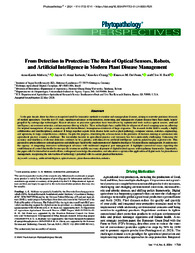From detection to protection: the role of optical sensors, robots,and arti?cial intelligence in modern plant disease management.
From detection to protection: the role of optical sensors, robots,and arti?cial intelligence in modern plant disease management.
Autoria: MAHLEIN, A. K.; BARBEDO, J. G. A.; CHIANG, K. S.; DEL PONTE, E. M.; BOCK, C. H.
Resumo: In the past decade, there has been a recognized need for innovative methods to monitor and manage plant diseases, aiming to meet the precision demandsof modern agriculture. Over the last 15 years, signi?cant advances in the detection, monitoring, and management of plant diseases have been made, largelypropelled by cutting-edge technologies. Recent advances in precision agriculture have been driven by sophisticated tools such as optical sensors, arti?cialintelligence, microsensor networks, and autonomous driving vehicles. These technologies have enabled the development of novel cropping systems, allowingfor targeted management of crops, contrasting with the traditional, homogeneous treatment of large crop areas. The research in this ?eld is usually a highlycollaborative and interdisciplinary endeavor. It brings together experts from diverse ?elds such as plant pathology, computer science, statistics, engineering,and agronomy to forge comprehensive solutions. Despite the progress, translating the advancements in the precision of decision-making or automation intoagricultural practice remains a challenge. The knowledge transfer to agricultural practice and extension has been particularly challenging. Enhancing theaccuracy and timeliness of disease detection continues to be a priority, with data-driven arti?cial intelligence systems poised to play a pivotal role. Thisperspective article addresses critical questions and challenges faced in the implementation of digital technologies for plant disease management. It underscoresthe urgency of integrating innovative technological advances with traditional integrated pest management. It highlights unresolved issues regarding theestablishment of control thresholds for site-speci?c treatments and the necessary alignment of digital technology use with regulatory frameworks. Importantly,the paper calls for intensi?ed research efforts, widespread knowledge dissemination, and education to optimize the application of digital tools for plant diseasemanagement, recognizing the intersection of technology’s potential with its current practical limitations.
Ano de publicação: 2024
Tipo de publicação: Artigo de periódico
Unidade: Embrapa Agricultura Digital
Observações
1 - Por padrão são exibidas publicações dos últimos 20 anos. Para encontrar publicações mais antigas, configure o filtro ano de publicação, colocando o ano a partir do qual você deseja encontrar publicações. O filtro está na coluna da esquerda na busca acima.
2 - Para ler algumas publicações da Embrapa (apenas as que estão em formato ePub), é necessário ter, no celular ou computador, um desses softwares gratuitos. Sistemas Android: Google Play Livros; IOS: iBooks; Windows e Linux: software Calibre.
Acesse outras publicações
Acesse a Base de Dados da Pesquisa Agropecuária (BDPA) para consultar o acervo completo das bibliotecas da Embrapa.

